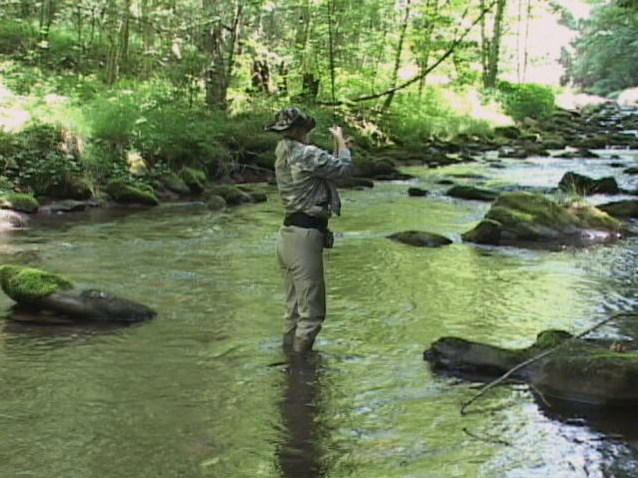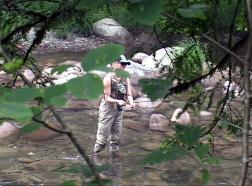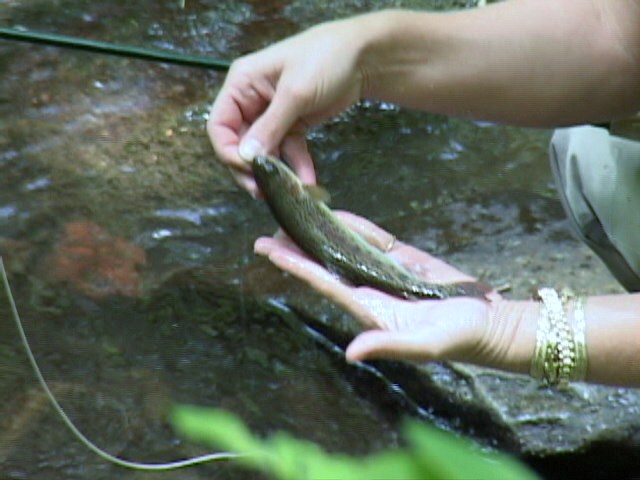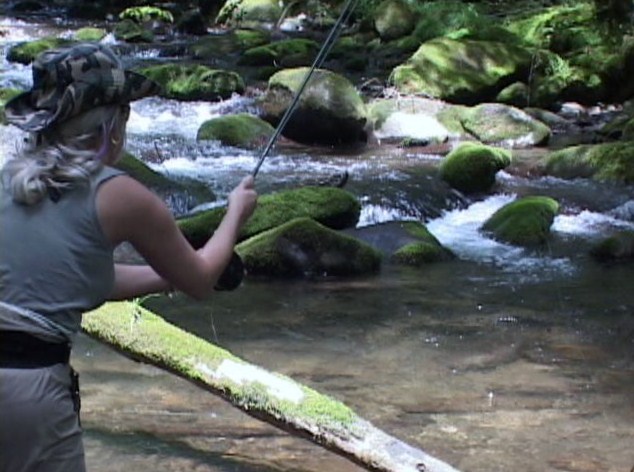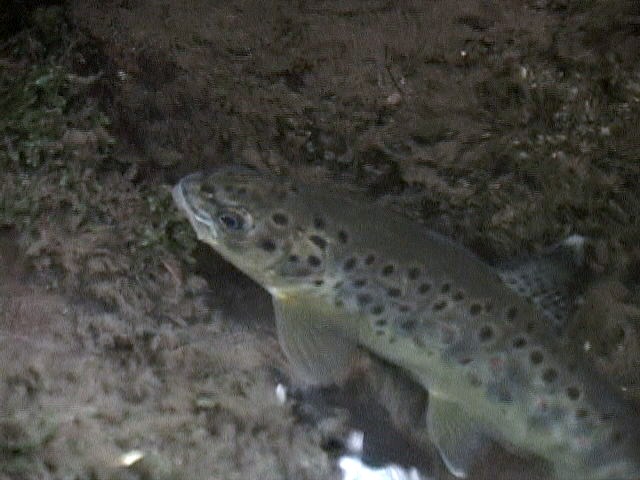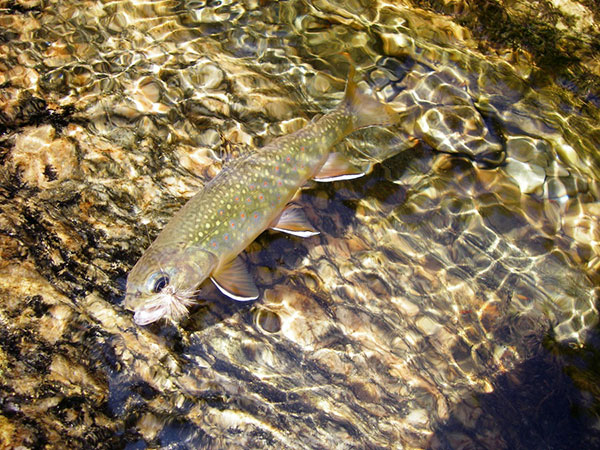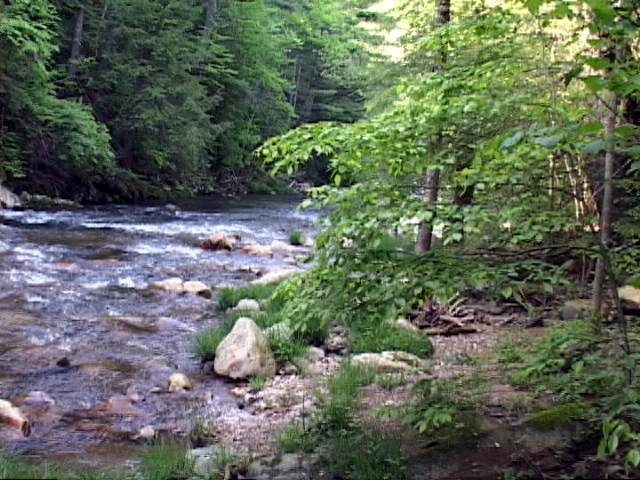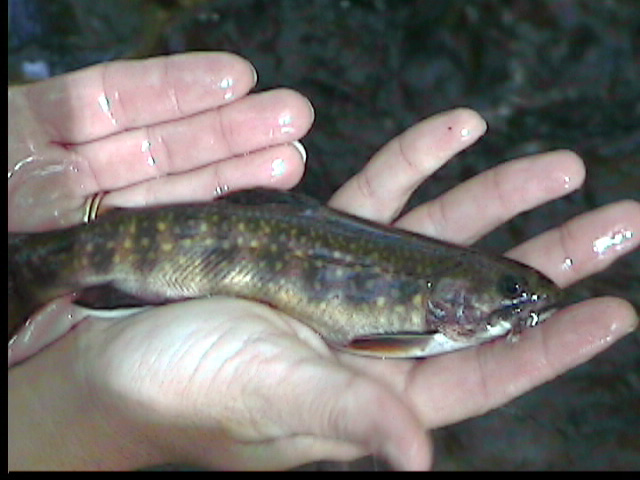
Summer, look for them in the
highly oxygenated water such
as plunges, below water falls
and swift runs.
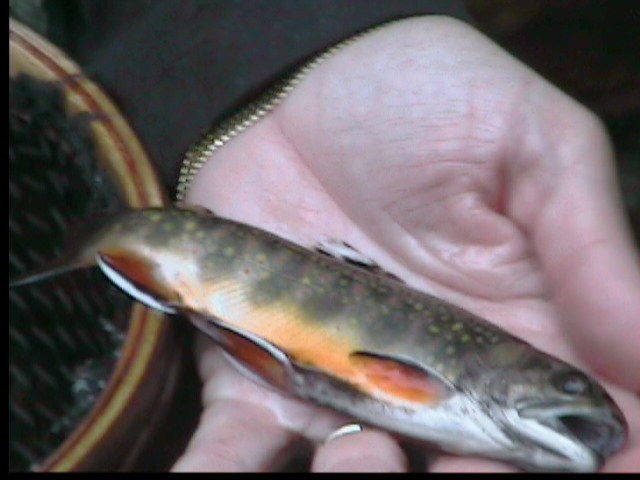
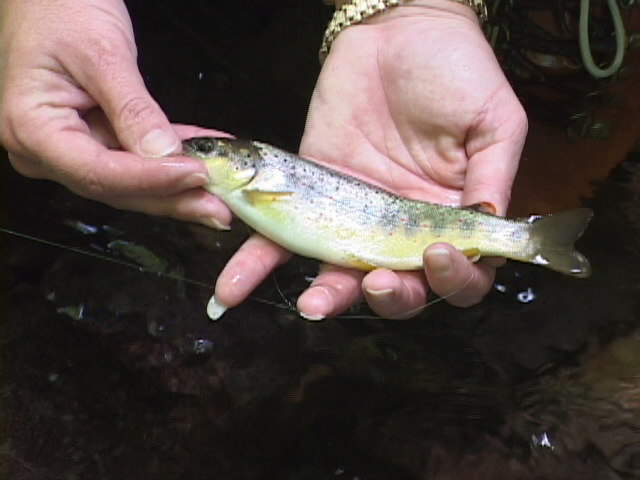

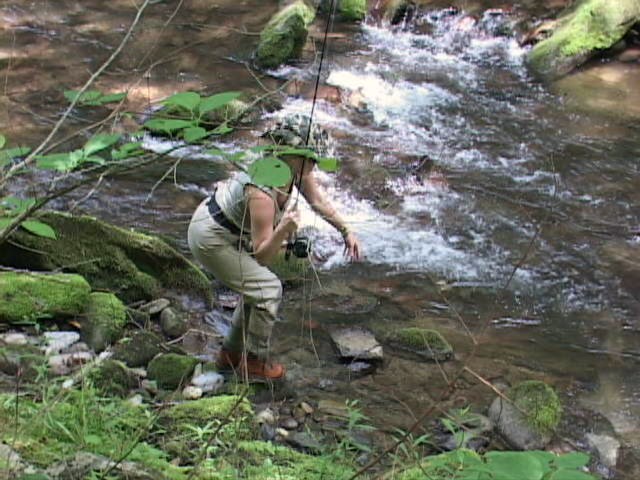
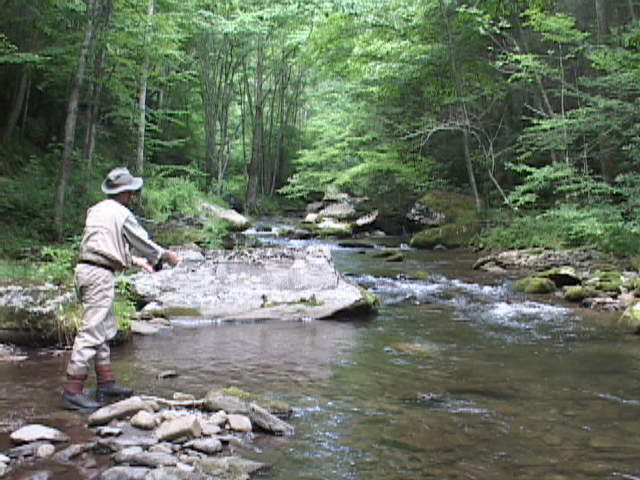
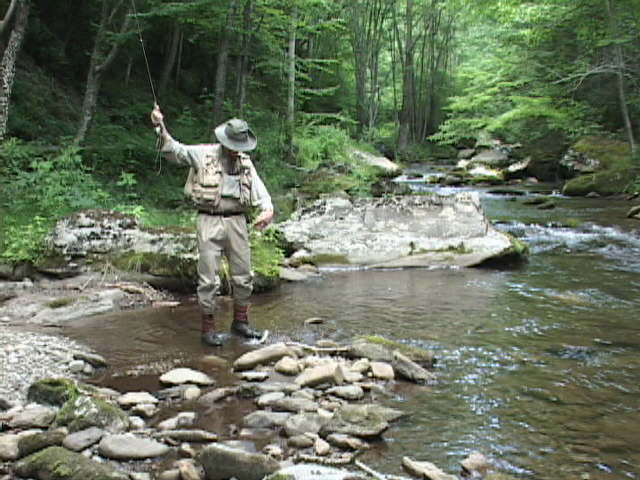
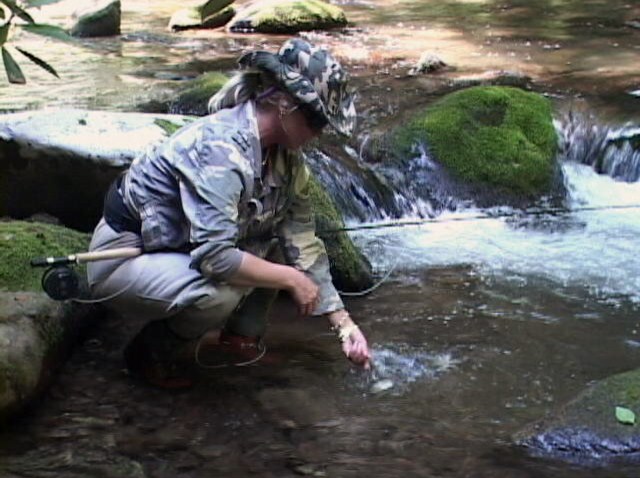
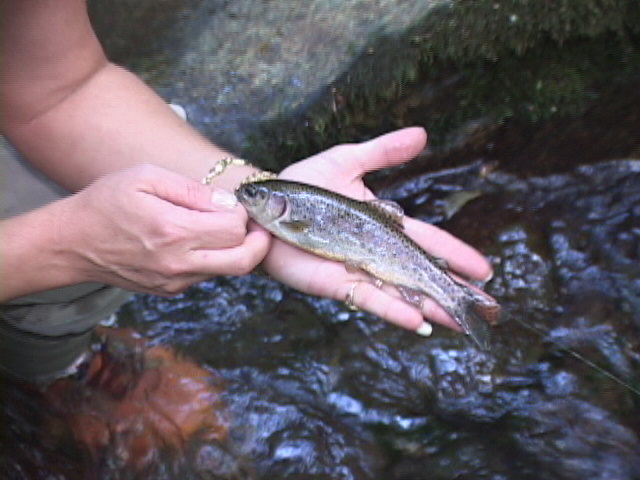
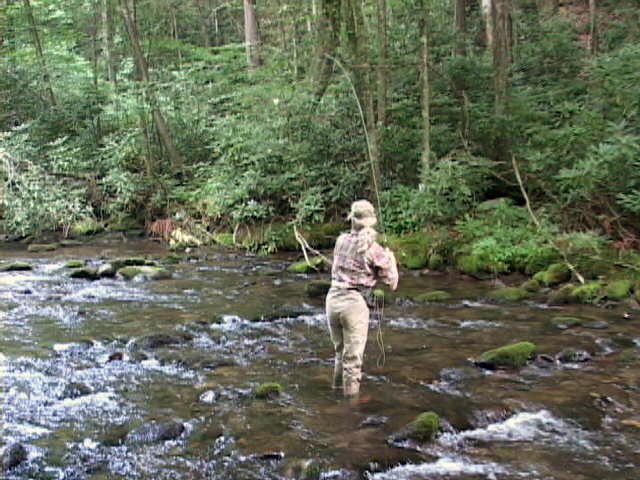
Summertime usually means low and warm water. Hopefully, daily thunderstorms will provide enough water to keep the stream reasonably full and that drought conditions are not experienced. Fly-fishing can be very enjoyable during the summer months especially in the higher elevations especially if you fish early and late in the day.
Remember that anglers are just a small portion of those who visit the park and that our concerns are no more important than people with other interest. While tubers and swimmers can be aggravating to us, they have just as much right to the streams as we do.
The daytime temperatures during the summer can range from the very comfortable mid seventies to the high nineties. In the park, the air temperature can vary quite a bit from the lower elevations to the higher elevations. Thunderstorms may occur daily for long periods of time and then some years they may be heavy for a while and not occur for an extended period of time. The Great Smoky Mountains National Park gets an average of about 100 inches of rainfall a year. With the exception of the Pacific Northwest, this is about as much as anywhere in the continental United States. The cool nights of the higher elevations of the forest is what keeps the freestone streams water temperature low enough to support trout.
Water Levels:
Water levels can become extremely low during periods of drought. Normally, the higher than normal amounts of rainfall keep the streams flowing well enough that the trout can survive. If a certain area of the park happens to get a heavy thunderstorm that drops a lot of water, then the streams within that drainage area may rise for a day or two. They usually never stay very high for long however. After they have been higher than normal for a day or two, the fish usually become very active.
Water Temperatures:
When the temperature of water gets warm it brings on another problem for the cold blooded trout. They must adjust to survive in water with less oxygen. The temperature and the oxygen content of the water are inversely proportional. That means that warmer water holds less oxygen than cold water but for every added degree of temperature there becomes a decreasingly proportional amount of oxygen. The difference in the dissolved oxygen content of the water with temperatures of 70 degrees F., and 75 degrees F., just for example, is substantial.
The water temperatures in the lower elevations of the park on certain streams can become too warm for the trout if there’s a long period of extremely hot weather. During this time the water temperatures may reach the low seventies. This makes it tough on the trout and they can even become lethargic. They feed very little if any during these times. Under these conditions the fish should not be caught.. The added stress of the fight is not good for them. Anglers should fish the higher elevations of park. It also helps to fish the more oxygenated areas of water or tiny water falls, plunges and narrow runs. The rainbow trout will seek out these area because of the extra dissolved oxygen the turbulent water adds. During these periods of time, the tree limbs we complain about when they catch our fly, saves the trout. Without the shade they provide the streams would become too warm for the trout even at the higher elevations. Cool rain water and cool nights in the higher elevations usually keeps the water cool enough for most of the trout to survive during these harsh times.
Anglers should also fish much earlier and later than they normally do. The water is a little cooler early in the mornings. By early, I don’t mean 9 o’clock. I mean 5 or 6 in the mornings and the last hour of daylight in the day. This not only helps you to catch trout, it also helps you avoid the tubers, swimmers and water lovers in many areas. Keep your thermometer handy during the summer. If the water temperature is over 68 degrees F., we suggest you move to a different area and look for cooler water.
Hatches:
Summertime hatches are not nearly as plentiful as they are in the Spring of the year but some of them extend on into the summer months. A few other species begin hatching during the summer.
Golden Stoneflies:
The Golden Stonefly, Perlidae family species, hatch during the months of late June, July and August. It is possible that you may find some of these stoneflies depositing their eggs in the late afternoon but shouldn’t be expected. Normally this occurs during the evening. The nymph and adult can be important but the nymph is the main stage to imitate. Like all stoneflies they crawl out of the water to hatch. These larger stoneflies are usually a hook size 8 or 10 but that can vary depending on the exact species.
Sulphurs:
There may still be a few Sulphurs, or Ephemerella dorthea hatches that are still occurring from Spring. This would only be the first part of June. These will be found only in a few places of slow to moderate water and only in isolated areas of some streams.
Cream Cahills:
Some Maccaffertium genus species, called Cream Cahills, hatch during the months of June, July and August. These usually come off in small numbers periodically during the afternoons and never in any concentrated fashion. The spinner falls can be more compacted and occur just before dark and on into the evenings. They are a hook size 12 to 16 depending on the species.
Light Cahills:
The Stenacron interpunctatum, or Light Cahill, can still be hatching during the month of June. These are a hook size 12 to 14.
The Maccaffertium genus ithaca species, also called a Light Cahill, hatches during the summer months. It is difficult to pin point a time. It usually is later in the summer or at least latter than the interpunctatum. These are a hook size 12 to 14.
Pale Evening Duns:
The Pale Evening Dun hatches of Ephemerella species also may still be occurring in some streams the first part of June.
Green Sedges:
Rhyacophila species known as Green Sedges can still be hatching during the month of June. The green rock worm is the most important stage to imitate.
Cinnamon (Spotted) Sedges (Abrams Creek):
In Abrams you will also continue to find some of the net-spinning caddisflies that hatch in the early part of Summer. These are mostly the Ceratopsyche species called Cinnamon Sedges.
Little Sister Caddis (Little Olive Sedge) (Abrams):
Cheumatopsyche or Little Sister Sedges also hatch continue to hatch in June.
Giant Stoneflies:
The Giant Stoneflies, members of the Pteronarcys dorsata genus, are still hatching in the month of June.
Summer Stoneflies:
Peltoperlidae family species, called Little Yellow or Summer Stoneflies, also hatch during the summer months. These are not very prolific and occur only in isolated areas of some streams. The nymphs (roach nymphs) are the important stage of life. The hook size varies with the particular species.
Little Yellow Stoneflies:
The Little Yellow Stoneflies, or Perlodidae family species, hatch during the months of June, July and August. There are several different species and sizes of these stoneflies. Most of them hatch during the late afternoons and evenings and deposit their eggs starting just before dark and into the evening. These range in hook size depending on the particular species. Look for them in the early part of Summer and again in late Summer.
Little Green Stoneflies:
Chloroperlidae family species, called Little Green Stoneflies, hatch in moderate water that is found in isolated areas of some of the streams in the park. These stoneflies hatch very late in the afternoons and on into the night. They deposit their eggs very late and in the evenings. The hook size varies depending on the particular species.
Slate Drakes:
The Slate Drakes hatch throughout the summer but never in any large quantities. There is a flurry of them in the late Spring and again in the fall, but the long hatch time slows down during the Summer. This is a long weird hatch. They are not bi-brooded.
Craneflies:
Craneflies can be found just about everywhere in the quite part of the streams or small pockets of calm water that can usually be found near the banks. Trout will eat them and it may be wise to have an imitation of the adults on hand.
Flying Ants:
Flying ants may appear on some streams during the month of August. Don’t hold your breath waiting on them because your chances of seeing flying ants are slim. Just be prepared just in case because the trout will definitely feed on them.
Ants:
There are plenty of ants around the streams and they sometimes get into the water, especially after heavy rains. Be prepared with both brown and black patterns.
Aquatic Beetles:
Aquatic beetles are in all of the streams in the park. They are usually not prolific in the fast pocket water typical of the park’s streams;however, there are several species of them.
Beetles:
Terrestrial beetles are very prevalent in the park. Make sure you give them a try. There is a tremendous variety of them. Great Smoky Mountains has a huge variety.
Grasshoppers:
Grasshoppers can be numerous in areas that have a lot of grass along the banks of the stream. It doesn’t take grass for a grasshopper to survive but we have never seen any large quantities of them where there was no grass. They come in all sizes and colors.
Inch Worms:
Inch worms of the Geometridae family, or the larva stage of moths, will be hanging from the tree limbs throughout the park in the early part of the summer months. These often fall into the streams and the trout seem to love them.
Copyright 2011James Marsh
